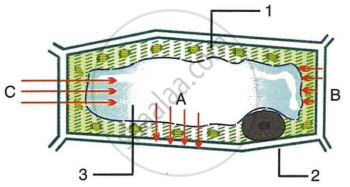Advertisements
Advertisements
प्रश्न
Differentiate between the following:
Turgor pressure and wall pressure
उत्तर
| Turgor Pressure | Wall Pressure | ||
| 1. | The hydrostatic pressure that endosmosis creates against the cell wall is known as turgor pressure. | 1. | The force that the cell wall exerts against turgor pressure is known as wall pressure. |
| 2. | Turgor pressure acts on the cell wall. | 2. | Cell wall pressure is generated by the cell wall. |
| 3. | Turgor pressure keeps plant stems upright, expands leaves and aids in the opening and closing of stomata, among other things. | 3. | Wall pressure maintains cell and plant structure. |
| 4. | The direction of Turgor pressure is towards the outside. | 4. | The direction of wall pressure is towards the inside of the cell. |
APPEARS IN
संबंधित प्रश्न
The diagram below represents a process in plants. The setup was placed in bright sunlight. Answer the following questions:

a) Name the physiological process depicted in the diagram.
Why was oil added to the water?
b) When placed in bright sunlight for four hours, what do you observe with regard to the initial and final weight of the plant? Give a suitable reason for your answer
c) What happens to the level of water when this setup is placed in:
- Humid conditions?
- Windy conditions?
d) Mention any three adaptations found in plants to overcome the process mentioned in (i).
e) Explain the term ‘Guttation’.
The state of a cell in which the cell wall is rigid and stretched by the increase in volume due to the absorption of water is called.
Give the equivalent term for the following:
The condition in which the cell contents are shrunken.
Differentiate between the following:
Turgidity and Flaccidity
What is the difference between ‘flaccid’ and ‘turgid’? Give one example of flaccid condition in plants.
Give Technical Term for the following.
A cell in a fully extended condition.
Give Technical Term for the following.
The pressure exerted by cell contents on a plant cell wall.
Name the following:
The condition in which the contents of a cell exert pressure against the cell wall making it distended.
Fill in the Blank
Wilting and drooping of leaves is due to loss of ________.
Given below is the figure of a plant cell showing different kinds of pressure acting upon it. Study the figure and answer the questions that follow:

- In the figure, 1, 2 and 3 represent:
- Cytoplasm, Nucleus, Vacuole respectively
- Vacuole, Cytoplasm, Cell wall respectively.
- Cytoplasm, Cell membrane and vacuole respectively.
- Cytoplasm, Cell wall and Vacuole respectively.
- B in the figure represents:
- Osmotic pressure
- Turgor pressure
- Wall pressure
- Diffusion pressure
- A in the figure represents:
- irnbibition pressure
- Wall pressure
- Turgor pressure
- Osmotic pressure
- C in the figure represents:
- Turgor pressure
- Osmotic pressure
- Wall pressure
- Imbibition pressure
- Draw a neat and labelled diagram of a plasmolyzed plant cell.
